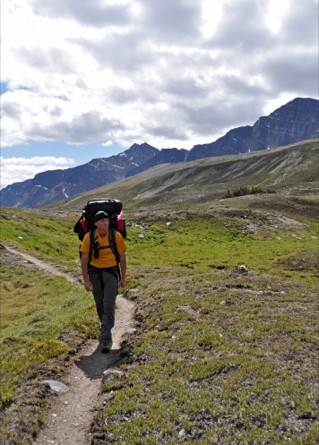Choose Your Own Adventure | Six Active Vacations for All Times of the Year
Although sipping rum drinks on the beach doesn’t sound like a bad way to spend those few, sacred vacation days, our guess is if you’re a Vermont Sports reader, exploring the peaks in the Himalayas or touching the bottom of the Grand Canyon is much more appealing. Actively exploring the world on foot, bike, skis, or snowboards means you see, smell, hear, and feel more than when you’re passive to your surroundings. Here, our writers share travel ideas to inspire you to make plans for your next great adventure.
Backpacking in the Canadian Rockies
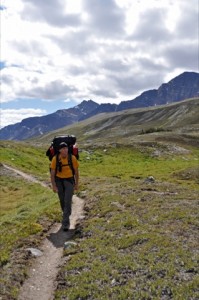
If you like hiking through fields of wild flowers and across expansive alpine valleys below snowcapped peaks with only the occasional caribou for company, put the Canadian Rockies on your backpacking bucket list. With fewer people and lower elevations compared to routes in the United States, an adventurous New Englander can breathe easier while getting a memorable Rocky Mountain high. The 30,000 square kilometers of Banff, Jasper, Yoho, Kootenay, and Waterton Lakes national parks as well as the half-dozen provincial parks along the Alberta-British Columbia border offer infinite possibilities, but first-timers will get the biggest bang for their backpacking buck using the town of Banff as a base. Numerous trailheads depart from the Icefields Parkway near Banff, including the classic six-day Jonas Pass–Brazeau Lake Loop where the biggest hazards are the bugs and bears.
Good to know: A Wilderness Pass and reservations at designated campsites and shelters are required, available at park visitor centers.
Best time to go: July through September
More info: Canadian Rockies Trail Guide by Brian Patton and Bart Robinson; www.pc.gc.ca
—Lisa Densmore
Denver-Area Ski Trip
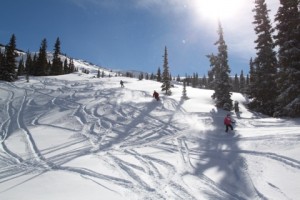
Show off your finely honed East Coast ski and ride skills at several resorts within driving distance from Denver, including Aspen/Snowmass, Vail, Copper, and Arapahoe Basin. Skiing out West is a different beast—the trails are generally longer, wider, and the snow is more forgiving. You’ll feel like a superhero, barring the altitude doesn’t hit you (stay hydrated and snack often to help your body stay strong). Try one of Vail’s famed back bowls, or Snowmass’ Long Shot (requires a short hike from the Elk Camp lift) for descents that seem to never end. Family-friendly Copper, with its indoor aerial park (you must try this!) and chill Arapahoe Basin don’t have the cachet of Vail and Aspen, but that can be a welcome relief for a down-to-earth New Englander. Colorado has it down when it comes to transport—if you stay at more reasonable off-mountain accommodations, it’s easy to find free transportation (buses) from hotel to base lodge. The après scene—heavy with authentic Mexican food, heady microbrews, and live music—rounds out the wild Western ski experience.
Good to know: Unless you have wider, powder skis, it’s worth renting demo skis made for Western terrain (and it can work out to about the same price as paying baggage fees to take your own skis). Southwest offers inexpensive flights between Hartford, Connecticut, and Denver.
Best time to go: January through March
More info: coloradoski.com
—Sky Barsch Gleiner
What Goes Down, Must Come Up: Hiking the Grand Canyon
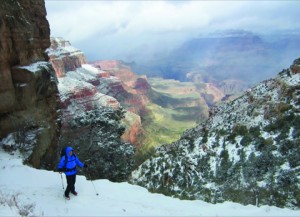
“No matter how many pictures you’ve seen, your first gaze across the expanse of the Grand Canyon is guaranteed to take your breath away,” says Jericho’s Chris Smith, who hiked down the Grand Canyon’s South Kaibab Trail and up Bright Angel in April with her husband, Dan Smith. The trail, Chris said, is solid footing, and the couple stayed at beautiful campsites. The canyon is 277 river miles long, 18 miles wide at its widest point, and one mile deep, and the park is home to more than 1,700 plant species, including a dozen endemic plants (meaning they grow nowhere else in the world). Spending time in the Grand Canyon is not for the inexperienced—summers can be very hot in the canyon, while spring or fall trips can provide quite the weather contrasts (“extremely unpredictable” in the words of the National Park Service). When the Smiths began their trip, it was 25 degrees at the rim, with four inches of fresh snow on the ground. They hiked down to the river, where temperatures were in the 60s. By the time they hiked up and out, it was in the 80s at the river and 60 at the rim. Due to the heat and scarcity of water, it’s imperative that you bring water and a water-filtration device.
Good to know: You’ll need a backcountry permit; this can be applied for four months in advance. The permits go quickly, so if you’re looking for an April vacation, it’s best to apply on the first of December.
Best time to go: spring or fall to avoid the summer heat.
More info: nps.gov/grca
—Phyl Newbeck
Cycling the Cabot Trail in Nova Scotia
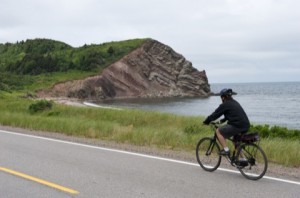
Traversing the spectacular highlands and rugged coastlines of northern Cape Breton, Nova Scotia’s 190-mile Cabot Trail is among the world’s most beautiful cycling routes. Paved, hilly, and moderately challenging (the longest climb stretches to over 1,200 feet above sea level), the Cabot Trail is full of options for exploring the region’s unique Gaelic, Acadian, and Mi’kmaq cultures, as well as its many remote and scenic hideaways. Catch some fiddle music in Cheticamp. Wander out to the very end of the province at Cape North. Imagine skiing to the sea at Cape Smokey. Keep your senses tuned and spot minke whales, moose, seals, and soaring eagles.
The Cabot Trail is a great option for self-supported cyclists, but a variety of guided tours are also worth looking into. Numerous lodging and camping options are available along the route, and it’s easy to get sidetracked by enjoying a good hike, some kayaking, or a tasty lobster salad sandwich along the way.
Good to know: The Cabot Trail passes through the heart of Cape Breton National Park, which offers numerous hiking routes along the coast and into the mountains that are worth exploring on foot.
Best time to go: May through October is the bike-touring season on Cape Breton. Avoid the busier months of July and August, however, if you’d prefer quieter roads.
More info: novascotia.com
—Brian Mohr
Trekking in the Annapurna Region
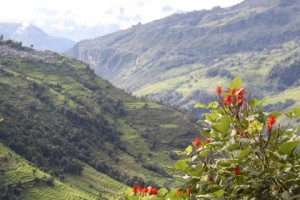
Om mani padme hum. This is the mantra I repeated over and over again, a syllable for each step as I traversed thousands of stone steps to reach Annapurna I Base Camp in Nepal. The relentless humidity, the dozens of leaches, earthquake (really!), and sheer physical exhaustion were worth enduring for the transformative experience of completing the Annapurna Base Camp Trek. Whether you are looking for a circuitous trek (Annapurna Circuit), a shorter climb (Poon Hill Trek), or something in the middle (Annapurna Base Camp, also called Annapurna Sanctuary Trek), the Annapurna Region in the Nepali Himalaya have something for you. You travel back in time and walk ancient paths, where the only mode of transportation is by foot or by mule. There are no cars, sparse electricity, and very little machinery—all building is done by hand, even stone for paths is crushed with hand tools (still, you get better cell reception than in Vermont). Tea houses and dining halls mean you don’t have to carry as much as you would on a traditional backpacking excursion, and helpful guides and porters keep you safe, and in our case, laughing.
Good to know: Trekking poles can do wonders on wet rocks—which you find everywhere. Medical attention is a long, long way away, so ditch the notion that poles are for the weak, and give yourself the extra help. Also, you need a permit from the Annapurna Conservation Area Project.
Best time to go: September to December (crowded during October and November), February to May
More info: ntnc.org.np
—Sky Barsch Gleiner
Hiking the Haute Route
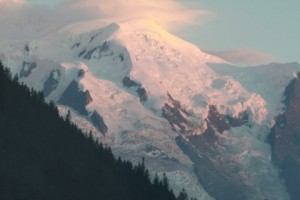
My partner Bryan and I hiked the Haute Route from Chamonix, France, to Zermatt, Switzerland, last summer. We covered roughly 10 spectacular miles a day for seven days with an average ascent/descent of 3,000 feet, often crossing over passes that gave us new views on a daily basis. We saw stunning snowcapped mountains and lush meadows with an assortment of wildflowers, often while listening to the tinkling of belled cows and goats that were grazing at high elevations. The Haute Route can be done at least partly from hut to hut while staying on the ridge line, or by descending into towns to stay in hotels. The advantage to huts, aside from price, is that you don’t have to start each day with an ascent and end with a descent. However, by staying in hotels, you have a more varied cultural experience, not to mention being able to buy fresh apricots, chocolate, and baguettes for on-trail lunches (although some huts offer lunch). Water is often available along the trail from hoses set out by local farmers. The Haute Route is well-marked, although the signs give the length of travel time rather than the distance. Some days required a bus or train ride, but the French and Swiss transit systems were easy to figure out. (A tour company helped us put together our itinerary, but there are books that can provide some of the same information.) July is the busy season, but aside from sections of trail near gondolas and trams, we never encountered crowds.
Good to know: No permits are needed.
Best time to go: Late June to early September.
More info: Cicerone’s Chamonix to Zermatt guidebook
—Phyl Newbeck

